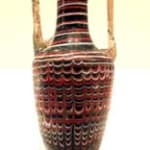Sand-Core Formed Glass Amphoriskos, 300 BCE - 200 BCE
Glass
2.25 x 6.375
X.0620
This marvelous third to second century B.C. “sand-core” formed amphoriskos – with its multicolored ribbons - is a delightful example of a visual style that was popular at that time...
This marvelous third to second century B.C. “sand-core” formed amphoriskos – with its multicolored ribbons - is a delightful example of a visual style that was popular at that time and would last well into the Roman period. Prior to the advent of glass blowing techniques pioneered by the Romans in the late Republic, cultures of the Mediterranean that practiced glass forming usually did so by winding molten strands of glass around a removable core. It was previously thought that such a technique employed a sand core, but it has now been recognized that more probably a core of straw-tempered mud was used, around which the glass would be formed. It is this visual impression of ribbons of colored glass that would influence the blown ribbon glass vessels of the early Roman principate.
This amphoriskos, with its swelling, broad-bellied midriff and sloping shoulder, leading from a tiny pedestal to a slender neck, flanked by two graceful handles, atop which sits a stout lip, displays a pastiche of blacks and reds interspersed with white, scalloped and spiraled around the vessel’s equator, appearing somewhat like a drapery of cloth. What sweet wines or perfumes may have graced the interior of this vessel, purchased by a husband, perhaps as a gift for his wife, or brought as a gift by honored guests? The dedication and skill of the craftsmen that formed this glass vessel are contained in the frozen, flowing rivers of color that comprise its walls and dazzle the eyes of the modern viewer, in much the same way that they must have bedazzled the ancient Mediterranean viewers as well.
Reference: John W. Hayes, Roman and Pre-Roman Glass in the Royal Ontario Museum. Toronto: The Royal Ontario Museum, 1975. See numbers 34-38.
This amphoriskos, with its swelling, broad-bellied midriff and sloping shoulder, leading from a tiny pedestal to a slender neck, flanked by two graceful handles, atop which sits a stout lip, displays a pastiche of blacks and reds interspersed with white, scalloped and spiraled around the vessel’s equator, appearing somewhat like a drapery of cloth. What sweet wines or perfumes may have graced the interior of this vessel, purchased by a husband, perhaps as a gift for his wife, or brought as a gift by honored guests? The dedication and skill of the craftsmen that formed this glass vessel are contained in the frozen, flowing rivers of color that comprise its walls and dazzle the eyes of the modern viewer, in much the same way that they must have bedazzled the ancient Mediterranean viewers as well.
Reference: John W. Hayes, Roman and Pre-Roman Glass in the Royal Ontario Museum. Toronto: The Royal Ontario Museum, 1975. See numbers 34-38.



